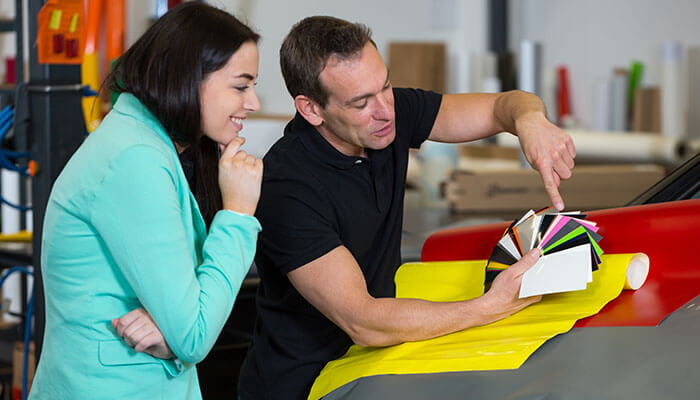Vinyl is an ideal material for graphics and can create attractive and durable custom displays. Custom vinyl graphics can be made using an adhesive backing for users to stick them to various surfaces. They are a convenient way to add personality to a space or advertise to customers using highly visible surfaces.
What Are Vinyl Graphics?
Used as a substrate to make printed graphics, vinyl is a versatile material that can be thick and rigid or thin and flexible. When used for adhesive vinyl graphics, it can be applied on a variety of surfaces. Businesses may use this type of graphic on their walls or windows as an advertising mechanism for ongoing sales and specials. Professional graphics that use Graphic Films are often designed to stay on a surface for an extended time with little upkeep.
How Do You Apply a Vinyl Graphic?
Each vinyl graphic comes with a release liner covering the adhesive on the back. The graphic is typically printed directly on the adhesive vinyl printing material. When ready to apply the piece on your preferred surface, peel back the liner to reveal the removable adhesive side. Make sure the application surface is clean and smooth for maximum adhesive strength. You can place the product on your surface of choice for the desired duration and remove it when needed, such as at the end of a business campaign or special offer.
Vinyl graphics can stick on most smooth and clean surfaces, depending on the type of adhesive used. Some suitable surfaces include:
- Metal
- Glass
- Plastic
- Wood
Vinyl is not usually recommended for surfaces that are:
- Textured
- Dirty
- Porous
- Oily
- Unfinished
A vinyl graphic’s permanence and level of stickiness are determined by many factors, including the surface it is applied to, the type of vinyl graphic used, the temperature of the environment, and the chosen location. Applying a vinyl image to a smooth wall indoors is more likely to stick longer than one applied to a rough wall in a wet location.
Why Choose Vinyl Graphics?
Vinyl graphics are a lightweight, low-maintenance, and customizable option, making them an ideal choice in the printing industry. They can also be laminated to increase their durability and weather resistance. Here are several advantages of choosing vinyl for your printed graphics:
Durable and Easy To Maintain
Vinyl images can be made with a durable overlaminate, making them resistant to water, sunlight, and scratches. These graphics are suitable for indoor decorations, outdoor signage, and floor graphics.
As a non-absorbent material, vinyl is also resistant to spills and stains making it easy to keep clean. If the vinyl surface gets dirty over time, you can wipe it with a damp cloth to help restore clarity and cleanliness.
Customizable
You can customize vinyl stickers by selecting the shape, size, type of vinyl adhesive, and finishing details that you need. Consider laminated vinyl graphics for extra protection and choose from glossy and matte finishes to get your desired look. The graphics can also be personalized with custom images and text, providing an effective way to make your brand’s color and message stand out. Businesses can match their brand’s signature colors on every graphic to fit seamlessly with other branded products and materials.
Lightweight and Simple To Install
These graphics are flexible and lightweight, making them easy to store and transport. The installation process is also easy and doesn’t involve a supply of tools or loose parts to complete.
Choose Quality Printing Materials for Your Vinyl Graphics
When purchasing vinyl printing materials for your graphics, choose a company that offers a variety of products for your intended use. Leading printing material companies can provide vinyl suitable for use on windows, walls, and more. If you need a durable and customizable option for your wall signs, consider vinyl graphics today.



